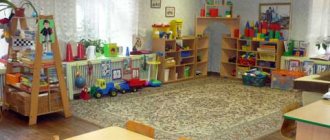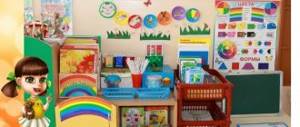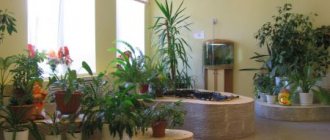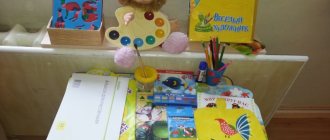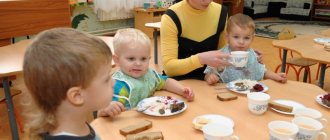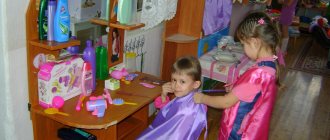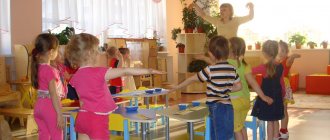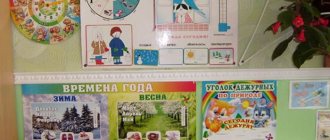Maintenance of environmental centers in groups of preschool educational institutions
Natalya Sugrina
Maintenance of environmental centers in groups of preschool educational institutions
Ugrina N.F.,
senior teacher
MBDOU No. 102
Maintenance of environmental centers in preschool educational institutions
The aggravation of environmental problems necessitates the formation of environmental consciousness and a culture of environmental management among the population. This work begins in the preschool educational institution, the first link in the lifelong education system.
Preschool childhood is the initial stage of the formation of a person’s personality, his value orientation in the world around him. During this period, a positive attitude towards nature, towards the “man-made world”
, to yourself and to the people around you.
Children's activities cannot be complete outside the subject environment, otherwise the child's desire to learn new things will disappear, apathy and aggression will appear. The surrounding space will help to avoid them, meeting the requirements of the current immediate and long-term creative development of each child, contributing to the timely identification and development of his abilities. An integral part of this space in a preschool educational institution is an ecological and developmental subject environment .
A specific feature of the method of environmental education for preschoolers is the child’s direct contact with objects of nature, “living”
communication with nature and animals, observing them, understanding what was seen during the discussion.
Indirect knowledge of nature (through books, slides, paintings, didactic games, etc.)
is also important: its task is to expand and complement the impressions that the child receives from direct communication with nature.
Therefore, in a preschool institution it is necessary to create environmental centers as important components of the ecological and developmental environment .
The main task of a developing ecological environment is to create conditions for the formation in children of a consciously correct attitude towards nature. The process of developing a consciously correct attitude towards nature is accompanied by independent observations, conducting experiments, and the child’s desire to talk about his experiences and impressions, discuss them, and embody them in various activities.
We have created environmental centers in each group . This allows the teacher to use them throughout the school year to conduct environmental and pedagogical activities and organize various types of children's activities: productive, communicative, labor, play, cognitive-research, musical-art, motor, perception of fiction.
Let's consider the content of environmental centers in the context of children's activities.
To organize productive activities of environmental content , card indexes of models for art activities were created, natural material for construction, attributes for non-traditional drawing, models of natural zones, biocenoses, models based on the works of writers V. Bianki, K. Ushinsky and others were collected. The most various natural materials: chalk, sand, stones, shells, feathers, coal and so on.
To organize gaming and communication activities in groups , games were selected to develop communication skills in preschoolers with environmental content , role-playing games “Tourists”
,
“Underwater World”
,
“Rural Yard”
. The teachers came up with and made various didactic games:
“On a tree - on the ground”
,
“Domestic and wild animals”
,
“Animals and babies”
,
“Match a leaf to a tree”
,
“Anthill and its inhabitants”
,
“Spring flowers”
,
“Day-night”
,
“Monkeys on a tree”
,
“Seasons”
.
Cognitive and research activities play a big role in the development of preschoolers’ cognitive interest and their creative activity. In all groups, scientist corners have been created to organize children's research activities in nature. Even the children of the first junior group , together with the teacher, conduct simple experiments. Microscopes, a globe, laboratory equipment, measuring glassware - all this is of particular interest to children. Children's experimentation not only provides children with an awareness of the connections and dependencies that exist in the natural world, but also provides an opportunity to practically master the basic skills necessary for organizing environmentally competent care for grown plants.
an ecological has been operating for many years - a natural area specially equipped for educational purposes, where conditions are created for educational and research activities. During walks and excursions along the ecological trail, children play , experiment, observe, learn not just to look, but also to see what surrounds them, and to talk about their impressions. They gain skills in time and space orientation and make sketches from life. They develop thinking, speech, memory. And most importantly, a sense of beauty appears, a love for nature is fostered, a desire to protect and preserve it. The green area of a preschool educational institution is of particular importance in an urban environment, where children are maximally isolated from the natural environment.
Each group “window gardens” since February.
, where there are onions, garlic, grain crops, flower seedlings. Children really enjoy watching plants. In addition to observation, they develop a sense of responsibility for the work they have started. The state of nature is noted daily and a corresponding picture is placed on the calendar. We try to encourage children, recognizing the most observant, diligent and active.
To organize work activities in the environmental center , materials and equipment for work activities have been collected (aprons, rags, sponges, oilcloth, spray bottle, watering cans, rakes, etc.) When selecting them, we took into account that materials and equipment must have a quality certificate and meet hygienic, pedagogical and aesthetic requirements.
Musical and artistic activities of environmental content are most fully reflected in the children's holidays “Visiting Autumn”
,
“Water Sorceress”
,
“Meet the Birds!”
,
“Earth Day”
and others. Holding such holidays helps children develop a sense of belonging to all life on the planet and fosters a caring attitude towards nature. During such events, competitions, games, competitions are usually held, exhibitions of children's drawings and photographic materials are organized, which also contributes to children's emotionally positive attitude towards the natural environment.
The environmental center contains works of art about nature: fairy tales, short stories, riddles, poems, proverbs and sayings, as well as models for telling poems and fairy tales.
The success of environmental education and training in preschool educational institutions depends on the use of various forms of work and their reasonable combination. When organizing work in different objects of the ecological and developmental environment, teachers of our preschool educational institution use various methods and forms of work with children, such as: didactic games, systematic observations, creating problem situations, experimental activities, organizing integrated classes, natural history conversations, the use of natural history literature, project activities, organization of excursions and hikes, environmental campaigns, holding holidays and leisure activities, labor activities to care for natural objects.
Thus, as a result of the application of modern approaches to environmental environmental education increases , which is expressed in a qualitatively new attitude towards nature. The leading personal achievement of a child becomes a truly humane attitude towards the greatest value - Life.
Literature
1. Nikolaeva S. Joint activities of adults and children // Preschool education. 2000. No. 5. P. 36-38.
2. S. N. Nikolaeva. Young ecologist : Program for environmental education of preschoolers. – M.: Mosaic-Synthesis. 2004.
3. O. V. Dybina, N. P. Rakhmanova, V. V. Shchetinina. The unknown is nearby - M.: Creative Center Sphere , 2001.
4. N. A. Ryzhova. Not just fairy tales. -M.: Linka-press, 2002.
5. Novoselova S. L. Developmental subject-game environment. // Preschool education. - No. 4. 2005.
MAGAZINE Preschooler.RF
System of work on nature conservation in preschool educational institutions One of the main tasks of the annual work plan of our preschool educational institution is the formation of an active position as a conservationist among children, parents and society; much attention is paid to environmental activities. Work on environmental protection in our kindergarten is carried out in a system and includes interaction with teachers, students, parents and society (public organizations): 1. Work with parents - informational parent meetings, design of information stands in groups, development of leaflets for parents, a competition of crafts made from waste material (garbage) “An orchestra is easy!”, essays and arguments from parents on the topic “Why it is necessary to recycle waste”, a master class “Do-it-yourself children’s musical instruments”. 2. Work with children - thematic classes, conversations, production of propaganda posters, exhibitions of children’s drawings, photo exhibition “How we collected garbage”, games with children on environmental education, watching the video “Don’t litter in the forest”, thematic reading of fiction, use of folklore material, artistic and musical sketches. 3. Teachers - participation in environmental competitions, consultations, round tables for parents, excursions to the library (“A little drop flies to the ground”). A systematic approach to the topic: “Don’t throw away garbage, or maybe it will start sounding!?” We use it in organizing the education of respect for nature and the development of musical ear and rhythm. The goal of the systematic approach is to teach children to treat their planet with care, not to pollute it, as well as to develop aesthetic feelings and reflect them in creative activities. Objectives of the systematic approach: 1. Education of a creative, humane, socially active personality. 2. Fostering a conscious, caring attitude towards nature. 3. Development of an ecological worldview and environmental-aesthetic education. 4. Development of children's musical abilities. To implement this approach, the following activities were carried out: - Consultation for parents on the topic: “The right attitude towards nature begins in the family”; — Creative living room for teachers on the topic “Children’s homemade noise musical instruments”; — Master class for parents on the topic “Do-it-yourself children’s musical instruments”; — Competition “Orchestra is easy!” to make the best musical instrument from waste material (garbage) - Consultation on the preschool educational institution website for parents and teachers on the topic “Don’t throw away garbage, what if it starts playing!” It is necessary to teach pupils from childhood that ecology is the science of the house, the house in which the child lives every day. He has the opportunity to understand that the beauty of nature, the fertility of the soil, and the diversity of animal species depend to a large extent on him. That tomorrow he will live in the same house as he builds it today. Appendix 1 MASTER - CLASS FOR PARENTS AND TEACHERS Children's homemade noise musical instruments Children's music playing is an active activity in which the child's thinking is improved; The ability to show initiative and independence develops. And most importantly, his emotional sphere is enriched - a kind of immunity from life’s failures. After all, emotions make it possible to evaluate current events from the point of view of their significance for each of us. In the process of playing instruments, each individual’s individual traits clearly manifest themselves: presence of will, emotionality, concentration, imagination. For many, this type of activity helps to reveal the spiritual world and overcome shyness and constraint. Nowadays there is a huge selection of children's musical instruments in stores. But not everyone is able to purchase these toys. Yes, and there is no need for this. After all, the child grows and develops so quickly, and the previous toys no longer satisfy the child’s cognitive needs. And the need for their renewal is growing every day. There is a good way out. You can design toys yourself and update and modify them over time. A handmade tool will help you teach your child to work together. To design, you don’t need much - desire and a little imagination! So let's show a little imagination and see what we can come up with. Rattle (noisemakers) Any small boxes and plastic jars (from Kinder surprises, creams and shampoos) filled one-third with rice, beans, peas, etc. can be used as noisemakers. materials that can make noise. Drum It can be made from empty mayonnaise jars or noodle boxes, or you can stretch thick paper soaked in water onto a small bucket or jar, tie it tightly with an elastic band or braid and let the paper dry. Bell It will require colored buttons, beads and a small bottle of mineral water. Buttons or beads are strung on threads, then the ends of the threads are secured upward under the bottle cap - the bell is ready. Funny little jokes To do this, you just need to take a used spool of tape, cardboard, and colored paper. Insert a pipe from an old toy and make 2 holes. Box You need to take a small box and paint it or cover it with colored paper. You can play the instrument with a wooden stick. Triangle For this tool you will need three metal tubes from a metallophone and a braid that is threaded through them. The instrument can be played with a wooden or metal stick.Tambourine
To make this tool we will need: a metal round candy box. We put various materials inside (cereals, beads, peas, beans, small buttons, etc.) Close the lid tightly and decorate.
Shakers
You can make it from cans of chips or children's tea: pour small cereals or peas inside, paint it on top or paste it with colored self-adhesive paper.
Noise bracelets
Can be made from colored hair ties and bells.
POSITION
about the competition “Orchestra is easy!” to make the best musical instrument
from waste material (garbage)
1. General Provisions
1.1. These Regulations determine the procedure and conditions of the competition “Orchestra - it's easy!” (hereinafter referred to as the Competition).
1.2. These Regulations establish the rights and obligations of competition participants, define the goals, objectives, procedure, procedure for organizing and conducting examination of competition materials, summing up and awarding winners.
2. Participants of the Competition
2.1. Parents, pupils and educators of all age groups can take part in the Competition.
3. Management of the Competition
3.1. The organizer of the competition is the administration of the State budgetary preschool educational institution kindergarten No. ___.
4. Purpose and objectives of the Competition
4.1. The purpose of the Competition: to foster a caring attitude towards nature and care for the limited resources of our planet.
4.2. Objectives of the Competition:
1. To attract the attention of parents, teachers and children to issues of human impact on the environment.
2. Help strengthen emotional ties within the family.
3. Establish and expand creative contacts with parents of preschool children.
5. Competition commission
5.1. A competition commission is created to prepare, organize and conduct the Competition and conduct the examination.
5.2. The commission includes specialists from State Budgetary Educational Institution No. ___ (Appendix 1).
5.3. Functions of the competition commission:
· accepts and evaluates works submitted for participation in the competition;
· organizes the competition, determines the day and place of its holding;
· carries out examination of competitive works;
· creates a list of winners of the Competition;
· organizes an award ceremony for the winners and participants of the Competition;
5.4. The chairman of the competition commission is obliged to:
· form the composition of the competition commission;
· hold meetings of the competition commission;
· monitor compliance with these Regulations;
· advise members of the competition commission on the content of the competition;
· manage the activities of the competition commission;
· distribute responsibilities among members of the competition committee;
· determine the procedure for the activities of the competition commission, the decision-making procedure and the form of the protocol.
5.5. Members of the competition commission are obliged to:
· comply with these Regulations;
· fill out expert sheets (according to Appendix 2) based on the results of the examinations;
· do not miss meetings of the competition commission without a good reason;
5.6. The result of the work of a member of the competition commission is an expert sheet filled out and signed with a fountain pen, which is issued to him by the secretary of the competition commission.
5.7. The completed expert sheets are handed over to the secretary of the competition commission.
6. Procedure and timing of the Competition
6.1. The competition is held from “___”_____ to “___”____________ 2013.
6.2. Competitive works are accepted "___"______________ 2013
6.3. The work of the jury to study competition materials and sum up the results of the competition
– “___”______________ 2013
6.4. Exhibition of works submitted for the competition in the kindergarten hall - “___”____________ 2013
7. Requirements for the content and design of competitive works:
7.1. Any work made by hand is accepted for the Competition. Store-bought crafts are not permitted.
7.2. The work can be done from any waste material.
7.3. The size of the craft does not matter.
7.4. The craft is accompanied by a label that states:
F.I. child, full name adult (parent, teacher), group number, name of the craft, material from which the craft is made.
7.5. The work must be aesthetically designed.
7.6. A child must participate in a joint competitive work.
8. Criteria for evaluating competition works
8.1. Originality.
8.2. Aesthetics.
8.3. Variety of materials used.
8.4. Possibility of practical use of crafts.
9. Summing up and awarding the winners of the Competition
9.1. The results of the Competition are summed up by the competition commission in the following nominations:
· Best children's work.
· Best Collaboration.
· Best adult work (category “Parent”).
· Best adult work (category “Teacher”).
The competition committee has the right to choose other nominations and awards for participants.
9.2. Based on the results of the competition, a winner, laureate and diploma holder are determined in each nomination.
9.3. The award ceremony takes place in a solemn atmosphere. The winners receive certificates and prizes.
9.4. The authors of the works who received the maximum score become the winners of the competition and are awarded certificates and gifts.
9.5. Photos of all crafts will be posted on the GBDOUDS website No. __.
| Next > |
Teach children to love nature
Bibliographic description:
Besedina, A.F. Teach children to love nature / A.F. Besedina. — Text: immediate // Aspects and trends of pedagogical science: materials of the II International. scientific conf. (St. Petersburg, July 2020). - St. Petersburg: Own publishing house, 2020. - pp. 25-27. — URL: https://moluch.ru/conf/ped/archive/216/12663/ (date of access: 10.10.2020).
The article tells a story about what needs to be done to instill in children a love for the world around them, the nature of their native land, through experiments and observations.
Key words: children, nature, environment, plants, observation, experimental activities
The world community is seriously concerned about the state of the environment, which is changing due to human fault. The seriousness of environmental problems is also recognized in our country. President V.V. Putin signed a Decree on holding the Year of Ecology in 2020 in the Russian Federation in order to attract public attention to issues of environmental development, ensuring environmental safety and preserving the diversity of nature.
However, the federal state standard for preschool education (FSES DO) does not mention either ecology or environmental education. The situation is different with environmental education, which is the formation in children of an emotional and value-based attitude towards nature.
The comprehensive development and upbringing of children is carried out by various means. One of them is familiarization with nature. Nature is an inexhaustible source of spiritual enrichment. Children come into contact with nature in one form or another. The infinitely diverse world of nature awakens keen interest and curiosity in children. It all starts with the means of folk pedagogy: fairy tales, jokes, proverbs, sayings, lullabies, in which everything is inspired by nature.
The role of fairy tales in the environmental education of preschool children can hardly be overestimated, and environmental fairy tales are interesting, first of all, because of the novelty of the plot and the introduction of unusual characters. Thanks to fairy tales, children can be told in an accessible form about complex phenomena in nature, the relationship between nature and man, and the importance of human labor. A special place is occupied by fairy tales that are invented by the children themselves.
“The world surrounding a child is, first of all, the world of nature with an endless wealth of phenomena, with inexhaustible beauty. Here, in nature, is the eternal source of reason,” said V. A. Sukhomlinsky.
However, not everything can be understood by children during independent communication with nature; the correct attitude towards plants and animals is not always formed. One of the main types of training for preschoolers is didactic games on environmental education. Thanks to them, children learn to see the signs of phenomena and objects, compare and classify them. Children learn new information about the natural world, developing memory and perception, reason about the life of animals and plants, developing thinking and speech. Didactic games promote the use of acquired knowledge for joint games, improving children's communication skills.
Introducing a child into the world of nature, forming realistic ideas about its objects and phenomena, cultivating the ability to see the beauty of their native nature, love, and caring attitude towards it is the most important task of adults. The acquired knowledge about the world around us must be supported by practical activities and clear examples so that children see the positive results of their activities and have a desire to improve their achievements. One of the most important areas in solving the problem of nature conservation is educational work with children.
Children are explorers by nature; they discover the world around them with joy and pleasure. They are interested in everything. And supporting a child’s desire to experiment and creating conditions for research activities is the task of all adults. The fact is that nature itself can be compared to a big, fascinating book. Every flower, every bird, every butterfly is a page from the Book of Nature. Reading it is not so easy to understand, to study nature.
Nature leaves a deep imprint on a child’s soul. It seems to him that he is a discoverer, that he was the first to hear the chirping of a grasshopper, to see that for him a starling sings, that snow is a lot of snowflakes.
Children look at the world around them with great interest, but they don’t see everything. And if nearby adults, who wonder with him, teach him to see, children will want to learn even more: about big trees and small beetles, about loud, cheerful birds and silent gloomy spiders, about wonderful flowers, colorful butterflies, furry bumblebees and about the most unlucky grass under your feet. The perception of nature helps to develop in children cheerfulness, emotionality, a sensitive, attentive attitude towards all living things. This can only be achieved if children are introduced to its secrets and shown interesting things in the life of plants and animals.
The main means of understanding nature is observation. Nature promotes mental development, logical thinking and speech, and develops artistic taste. Nature is full of extraordinary wonders. It never repeats itself. Children should know that man transforms nature in order to protect and improve it.
In the implementation of the tasks of environmental education, the natural environment is of great importance - the creation of a corner of “scientific research in nature”, where children could care for plants; this is the organization of systematic observations of natural phenomena and objects; as well as introducing children to regular work in nature. We are used to taking armfuls of flowers, branches of coniferous trees, mushrooms, berries, and various animals from the forest. It is necessary to cultivate in children the desire to admire unplucked flowers, to have the need not only to take from nature, but also to give to it.
The ecological culture of people, their relationship with nature depends on the general culture. The roots of ethical behavior in nature are laid not only in kindergarten, but also in the family. From childhood, a child should know by sight the jackdaw, starling, mint, lungwort, animals and other plants around him, what can be taken from nature in limited quantities, and what cannot be touched at all.
Environmental education of preschoolers consists of familiarization with the species composition of plants and animals of the local region. Interconnection with the environment is achieved by reading books about nature, organizing observations of seasonal changes in the life of plants and animals, small experiments with plants and animals in different conditions (at home, in the country, and so on). Children are little explorers. They strive to take everything in their hands and examine it, so the surrounding plants and animals become the object of their interest.
Using every free hour, it is advisable to go with the children to the field, forest, to the shore of a pond, to the river, etc. And the more often, the better. The most inconspicuous ravine, overgrown with bushes, is fraught with amazing things, if only an adult himself can see them and open the eyes of a child to them.
During walks, it is advisable to pay the child’s attention to the beauty and features of the season: the length of the day, the nature of precipitation, the strength and direction of the wind. It is advisable to show children the sun, moon, stars, sunset and sunrise, changes in the shape of the moon, buds opening, leaves falling, fruiting, a state of relative rest and much more. During walks, you need to teach your child to distinguish spruce from pine and larch; you can show oak, elm, poplar, birch, and linden. Trees are recognized by their leaves, buds, bark, and the characteristics of their needles. To help children remember names faster, plants need to be “humanized.” It is interesting to compare the needles of pine and larch in terms of color, size of needles and stiffness of the cones of these plants. This comparison greatly helps children in further memorizing the names of trees and easily recognizing them. They understand well that trees and shrubs cannot be broken, that they are in pain, and that a damaged tree or shrub grows poorly.
Let the child recognize some new plant on every walk. However, at the same time, children must be strictly warned that they cannot tear anything in a public garden, park, or forest. Of course, the environmental development of children in kindergarten will be more effective if it is interconnected with environmental education in the family. Therefore, teachers should encourage parents to create favorable conditions for an ecological and developmental environment at home.
Many parents are environmentally illiterate; they cannot give their children basic knowledge about nature, but place responsibility for education and upbringing on educational institutions. In communicating with them, it is necessary to convey the idea that the formation of a culture of love for nature must begin with oneself. It is important to be an authority and role model for a child.
Often in the spring forest you can see families collecting early flowering plants. Their mass collection occurs in the first half of summer. The Law on Nature Protection and special decisions prohibit the mass collection of primroses, such as corydalis, lungwort, spring primrose, lumbago (sleep grass), as well as lily of the valley and bathing suit, peach bell and other rare plants. They are listed in the Red Book. It is worth informing parents that mass collection of flowers in bouquets is poaching.
To satisfy cognitive interest, it is quite enough to make a small bouquet of one or three flowers with the addition of some greenery. But when collecting flowers, it is necessary to protect their underground part; the plant cannot be uprooted from the ground; immediately show the child how to put the flowers in a vase so that the flowers do not quickly wither.
It seems that there is nothing simpler than picking berries, but it turns out that here too we need to take care of nature conservation. Under no circumstances should you break branches with berries from rose hips, viburnum, bird cherry and other shrubs. In such cases, you can ask children questions like: “What does this plant feel now?” or “What might they think of you?”
When picking mushrooms, children need not only to be shown various edible mushrooms, but to focus on external signs. When picking mushrooms, children are shown how to cut off the fruiting body with a knife or twist it out of the ground so as not to damage the mycelium and at the same time explain that digging up the mycelium is prohibited. It is necessary to pay serious attention to poisonous mushrooms; they cannot be collected or trampled under foot, as they play their irreplaceable role in the life of the forest. These mushrooms are a chain in the nutrition of living organisms in nature.
Children are often involved in collecting medicinal herbs. The child needs to be told which part of the plant is collected and how exactly. And what is it used for? It is also advisable to show some honey plants, such as linden, yellow and white sweet clover, buckwheat, and watch how bees visit their flowers.
If a child is at the dacha, he should not be a passive observer while adults are working. He can participate in sowing and harvesting, but at the same time he needs to tell them about the plants and how to collect them. It is useful to perform search and research tasks. For example, find sick plants and help them by putting up a sign with a green cross - “in need of treatment.”
At the end of winter, you and your child can plant a small vegetable garden in the window: plant onions, garlic, and dill. At first, the child is involved sporadically in caring for plants at home, but gradually and independently can water them. Remind children more often that nature should not only be admired, but also helped.
Adults should instill in children the habit of caring for nature in general, the forest, and the reservoir. And it is important to be an example, a model of behavior in nature. Since ancient times, people have taken a lot from her. At the same time, they often did not return what she needed and did not take care of her. As a result, many disasters happened: many plants disappeared, hundreds of bird and animal voices fell silent forever. Disappeared plants and animals can now only be seen in drawings, sometimes in photographs. Some bodies of water have turned into sewers. Following the felled forests, once full-flowing rivers, streams, and lakes dried up completely or remained “puddles.” Nature has lost a lot, which means we have lost too. Therefore, protecting our native nature is the responsibility of everyone and everyone separately.
Literature:
- Vasilyeva A.I. Teach children to love nature. –Minsk: Narodnaya Asveta, 1972
- How to introduce preschoolers to nature. / Ed. P. G. Samorukova. M.: Education, 1983.
- Voronkevich O. Welcome to ecology. -SPb., 2003.
- Lucic M. Children about nature. -M., 1989.
- Dobrynina O. The unknown is nearby. -M., 2001.
- Serebryakova T. A. Environmental education in preschool age. -M., 2008.
Key terms
(automatically generated)
: child, nature, plant, environment, environmental education, animal, environment, respect, kindergarten, native nature.
